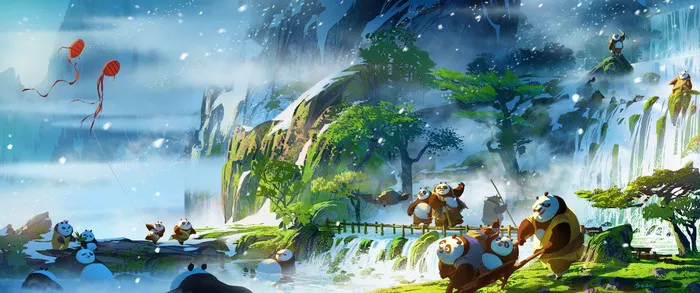Released on June 6, 2008, “Kung Fu Panda” is an animated feature film that has left a significant mark on the landscape of global cinema. Produced by DreamWorks Animation and distributed by Paramount Pictures, this film not only achieved critical and commercial success but also sparked a franchise that includes sequels, television series, and a substantial range of merchandise. This article explores the release, reception, and lasting influence of “Kung Fu Panda” in the broader context of animated filmmaking.
Origins and Development
Concept and Creation: The concept of “Kung Fu Panda” originated from a conversation between DreamWorks Animation executives and film producers. Inspired by a love of kung fu and classic martial arts films, the creators aimed to blend these elements with the appeal of an underdog story set in a captivating animal world. The character of Po, a clumsy panda with dreams of martial arts mastery, served as a relatable protagonist whose journey speaks to the universal theme of self-discovery and achieving one’s potential.
Production Challenges: The development of “Kung Fu Panda” involved overcoming several challenges. The animators undertook extensive research into Chinese culture and martial arts to ensure the film’s authenticity and respectfulness towards the elements it portrayed. The animation team also faced the technical challenge of creating detailed and visually appealing animation sequences that accurately represented kung fu movements.
Release and Box Office Performance
Release Date: “Kung Fu Panda” was officially released in the United States on June 6, 2008. The timing of its release allowed it to capitalize on the summer audience, a prime season for family and children’s films.
Box Office Success: Upon its release, “Kung Fu Panda” received a warm reception at the box office, grossing over $20 million on its opening day and approximately $60 million in its opening weekend. It ultimately earned around $631.7 million worldwide, making it one of the highest-grossing films of 2008 and the highest-grossing animated film of the year until it was surpassed by DreamWorks’ own “Madagascar: Escape 2 Africa.”
Critical Reception
Reviews and Ratings: “Kung Fu Panda” was praised for its humor, heartwarming story, and impressive animation. Critics highlighted the voice performances, particularly Jack Black as Po and Dustin Hoffman as Shifu, which added depth and charm to the film. It holds a high rating on various review aggregation websites, which reflects its broad appeal and critical approval.
Awards and Nominations: The film was nominated for multiple awards, including an Academy Award for Best Animated Feature. Although it did not win this Oscar, losing to Pixar’s “WALL-E,” it won several Annie Awards and other accolades that underscored its artistic achievements and appeal to both children and adults.
Cultural Impact and Themes
Promotion of Chinese Culture: One of “Kung Fu Panda’s” most significant impacts was its respectful and enthusiastic portrayal of Chinese culture. By integrating traditional Chinese elements into its storytelling and visual design, the film served as a bridge to introduce these aspects to a global audience. This approach also sparked conversations about cultural representation in animation, highlighting the importance of sensitivity and accuracy in depicting cultures different from one’s own.
Themes of Self-Acceptance and Perseverance: At its core, “Kung Fu Panda” is a story about self-acceptance, inner strength, and the pursuit of one’s dreams. Po’s journey from a noodle shop worker to a kung fu master is not just a physical transformation but also a metaphorical exploration of personal growth. The film’s messages about believing in oneself and persevering despite obstacles resonate with viewers of all ages.
Expansion into a Franchise
Following the success of the original film, “Kung Fu Panda” expanded into a significant franchise.
Sequels: “Kung Fu Panda 2” was released in 2011, followed by “Kung Fu Panda 3” in 2016. Both films continued the story of Po and the Furious Five, delving deeper into Po’s background and the lore of the universe.
Television and Other Media: The franchise also branched out into television with series such as “Kung Fu Panda: Legends of Awesomeness” and “Kung Fu Panda: The Paws of Destiny.” Additionally, there are numerous video games, a theme park attraction, and an extensive range of merchandise, from toys to apparel.
Legacy and Future
Influence on Animation: “Kung Fu Panda” has influenced the field of animation by demonstrating how blending cultural homage with universal storytelling can create a deeply engaging and successful film. The film’s impact extends beyond its box office earnings, influencing subsequent animated films and series in terms of content, thematic depth, and cultural sensitivity.
Future Prospects: As of now, the legacy of “Kung Fu Panda” continues to grow. DreamWorks has hinted at potential further expansions, including possible additional sequels and related projects, ensuring that Po’s journey and the lessons he embodies will continue to inspire audiences for years to come.
Conclusion
Since its release on June 6, 2008, “Kung Fu Panda” has grown from a single film into a beloved global franchise. Its blend of humor, heart, and effective cultural representation has set standards in the animated film industry. The legacy of “Kung Fu Panda” is a testament to the power of storytelling and its ability to convey universal themes of growth, resilience, and the pursuit of one’s dreams. As it continues to entertain and inspire, “Kung Fu Panda” remains a significant cultural phenomenon in the world of animation.


